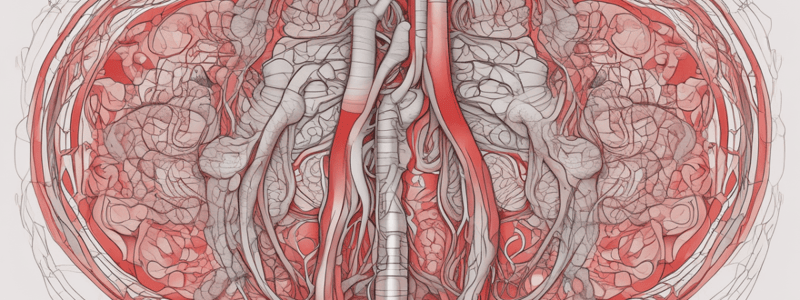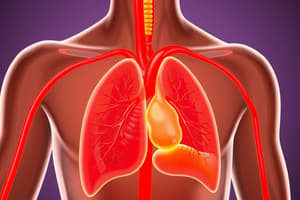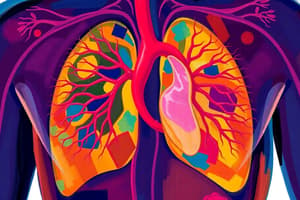Podcast
Questions and Answers
What is the role of the pulmonary circulation?
What is the role of the pulmonary circulation?
- To deliver nutrients to the body tissues
- To return blood to the heart from the systemic circulation
- To transport deoxygenated blood to the lungs (correct)
- To supply oxygen-rich blood to the major systems
Which statement correctly describes the systemic circulation?
Which statement correctly describes the systemic circulation?
- It delivers blood to the capillary beds throughout the body (correct)
- It returns deoxygenated blood to the right side of the heart
- It involves the flow of blood only in the heart
- It transports oxygen-rich blood from the lungs to the heart
Which chamber of the heart receives oxygen-rich blood from the lungs?
Which chamber of the heart receives oxygen-rich blood from the lungs?
- Left atrium (correct)
- Right atrium
- Right ventricle
- Left ventricle
What happens to blood circulation in the fetus compared to after birth?
What happens to blood circulation in the fetus compared to after birth?
Which structure is responsible for carrying deoxygenated blood toward the lungs?
Which structure is responsible for carrying deoxygenated blood toward the lungs?
What does the term 'double circulation' refer to?
What does the term 'double circulation' refer to?
What role do the chordae tendineae play in the heart?
What role do the chordae tendineae play in the heart?
What is the conus arteriosus also known as?
What is the conus arteriosus also known as?
Which condition is associated with a hole in the heart due to improper development of the infundibulum?
Which condition is associated with a hole in the heart due to improper development of the infundibulum?
What percentage of the population may have a patent foramen ovale?
What percentage of the population may have a patent foramen ovale?
Which of the following conditions is characterized by a complete absence of the inter-atrial septum?
Which of the following conditions is characterized by a complete absence of the inter-atrial septum?
What is a common consequence of a persistent interventricular foramen?
What is a common consequence of a persistent interventricular foramen?
What is the primary function of the moderator band?
What is the primary function of the moderator band?
Which of the following best describes a significant feature of the right ventricle's septal wall?
Which of the following best describes a significant feature of the right ventricle's septal wall?
What feature distinguishes the fetal circulation from adult circulation?
What feature distinguishes the fetal circulation from adult circulation?
Which statement correctly describes the journey of deoxygenated blood in the heart?
Which statement correctly describes the journey of deoxygenated blood in the heart?
What is the primary function of the aorta in the adult cardiovascular system?
What is the primary function of the aorta in the adult cardiovascular system?
Which fetal structure is responsible for bypassing the lungs?
Which fetal structure is responsible for bypassing the lungs?
What major change occurs in the circulatory system at birth?
What major change occurs in the circulatory system at birth?
What issue may arise from persistent fetal structures post-birth?
What issue may arise from persistent fetal structures post-birth?
How does deoxygenated blood return to the heart in adults?
How does deoxygenated blood return to the heart in adults?
What is the role of the pulmonary veins in the adult circulatory system?
What is the role of the pulmonary veins in the adult circulatory system?
What ensures that the amount of blood ejected from both the right and left hearts is the same?
What ensures that the amount of blood ejected from both the right and left hearts is the same?
Which structure is responsible for bypassing the pulmonary circulation in the fetus?
Which structure is responsible for bypassing the pulmonary circulation in the fetus?
Why is the pulmonary side of circulation high pressure in the fetus?
Why is the pulmonary side of circulation high pressure in the fetus?
What happens to the ductus arteriosus after birth?
What happens to the ductus arteriosus after birth?
What is the function of the ductus arteriosus in fetal circulation?
What is the function of the ductus arteriosus in fetal circulation?
What type of blood enters the right atrium from the superior vena cava in the fetal circulation?
What type of blood enters the right atrium from the superior vena cava in the fetal circulation?
What is the outcome of a significant patent foramen ovale?
What is the outcome of a significant patent foramen ovale?
How does the pressure gradient change at birth?
How does the pressure gradient change at birth?
What role does the foramen ovale play during fetal development?
What role does the foramen ovale play during fetal development?
What denotes the closure of the foramen ovale post-birth?
What denotes the closure of the foramen ovale post-birth?
What mixture causes blood from the inferior vena cava to be partially oxygenated in fetuses?
What mixture causes blood from the inferior vena cava to be partially oxygenated in fetuses?
How does the pressure within the pulmonary system compare to that of the systemic system in fetal circulation?
How does the pressure within the pulmonary system compare to that of the systemic system in fetal circulation?
What is the cause of probe patency in the foramen ovale?
What is the cause of probe patency in the foramen ovale?
What condition arises when blood flows from left to right due to a patent foramen ovale?
What condition arises when blood flows from left to right due to a patent foramen ovale?
What percentage of the population experiences probe patency without pathological effects?
What percentage of the population experiences probe patency without pathological effects?
What is the primary function of oxygenation in the placenta?
What is the primary function of oxygenation in the placenta?
Flashcards are hidden until you start studying
Study Notes
Systemic and Pulmonary Circulation
- Systemic circulation delivers oxygen-rich blood to body capillary beds and returns deoxygenated blood to the heart.
- Pulmonary circulation starts at the right side of the heart, sending oxygen-depleted blood to the lungs via the pulmonary trunk for gas exchange.
- Oxygen-rich blood returns to the left side of the heart, re-entering the systemic circulation.
Heart Chambers
- The heart consists of four chambers, serving two circulatory systems: pulmonary (right) and systemic (left).
- Right atrium receives deoxygenated blood from the body via the venae cavae, passing it to the right ventricle through the right atrioventricular valve.
- Blood is pumped from the right ventricle to the lungs for oxygenation before returning to the left atrium.
- The left atrium transfers blood to the left ventricle via the left atrioventricular valve, which then ejected through the aorta.
Chordae Tendineae and Papillary Muscles
- Chordae tendineae are fibrous cords attached to papillary muscles in the ventricles, preventing valve cusps from inverting during contraction.
- The moderator band is a conducting system component that helps coordinate heart contractions.
Ventricular Septal Defect (VSD)
- VSD occurs when the infundibulum does not develop correctly, creating a hole in the heart between ventricles.
- Atrial septal defects (ASDs) are common, with about 20% of the population having a small foramen ovale, often without significant health issues.
- Larger septal defects can lead to severe conditions, including common atrium syndrome.
Fetal Circulation
- Fetal circulation is distinct from post-birth circulation, as the lungs are not functional until the first breath.
- Blood bypasses the pulmonary system via the foramen ovale and ductus arteriosus.
- High pressure in the pulmonary arteries directs deoxygenated blood from the right atrium to the left atrium through the foramen ovale (80% of blood).
- The ductus arteriosus connects pulmonary trunk to aorta, allowing blood to circumvent the non-functional lungs.
Changes at Birth
- At birth, the first breath opens the lung beds, decreasing pressure in the pulmonary system.
- This change triggers closure of the foramen ovale (becomes fossa ovalis) and ductus arteriosus (becomes ligamentum arteriosum).
Patent Ductus Arteriosus and Foramen Ovale
- Patent foramen ovale fails to close properly, potentially causing oxygenated blood to flow back into circulation instead of to the body, detected in 20% of individuals.
- A patent ductus arteriosus leads to serious complications, forcing blood from the aorta back into the pulmonary arteries.
Conclusion
- Understanding the structure and function of heart chambers, as well as the differences in circulation pre- and post-birth, is crucial for studying cardiovascular physiology.
- Further lectures will cover the conducting system, coronary circulation, and heart valves.
Studying That Suits You
Use AI to generate personalized quizzes and flashcards to suit your learning preferences.




